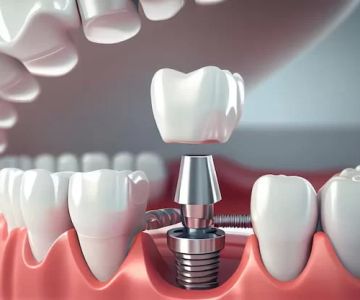What is Osseointegration in Dental Implants? A Complete Guide
- Understanding Osseointegration in Dental Implants
- The Science Behind Osseointegration
- How Osseointegration Affects the Success of Dental Implants
- The Osseointegration Process: Step-by-Step
- Factors That Influence Osseointegration
- What Happens If Osseointegration Fails?
Understanding Osseointegration in Dental Implants
Osseointegration is the process by which a dental implant fuses with the jawbone, providing a stable base for replacement teeth. The term "osseointegration" comes from the Greek word "os" meaning bone and "integration" referring to the bonding process. It is a critical step in the success of dental implants, ensuring they stay securely in place and function like natural teeth.
This biological process involves the gradual attachment of the implant surface to the bone, allowing it to become a part of the jaw structure. Once osseointegration is complete, the dental implant can support crowns, bridges, or dentures without the need for removable options like traditional dentures or bridges.
The Science Behind Osseointegration
Osseointegration relies on the body's natural healing process. When a dental implant is placed into the jawbone, the bone begins to grow around the implant, creating a strong and permanent bond. This happens because the surface of the implant is typically made from titanium, a material known for its biocompatibility, which encourages bone cells to attach and grow.
The implant acts as an anchor, and the surrounding bone integrates it into the jaw structure over time. The success of osseointegration depends on several factors, including the quality of the bone, the health of the patient, and the technique used by the dentist.
How Osseointegration Affects the Success of Dental Implants
Osseointegration is a crucial factor in the overall success of dental implants. It determines the stability and long-term functionality of the implant. When osseointegration occurs properly, the implant becomes a permanent part of your mouth, capable of supporting replacement teeth that look and function like natural teeth.
If osseointegration is unsuccessful, the implant may fail to secure in the jawbone, resulting in discomfort, instability, and even implant rejection. However, with proper care and a skilled dental professional, osseointegration generally succeeds in 95-98% of cases, making dental implants one of the most reliable solutions for missing teeth.
The Osseointegration Process: Step-by-Step
The osseointegration process typically occurs in several stages after the dental implant is placed. Here’s a breakdown of the process:
- Placement of the Implant: The first step involves the surgical placement of the dental implant into the jawbone. The implant is usually placed in the bone socket where the missing tooth was located.
- Healing and Bone Growth: After the implant is placed, the body begins to heal. Over the next few months, bone cells start to form around the implant, securing it firmly in place.
- Integration with Bone: During this healing phase, the bone naturally fuses with the implant’s surface, completing the osseointegration process. This can take several months, depending on the individual’s healing capacity.
- Final Restoration: Once osseointegration is complete, your dentist will place a custom-made crown, bridge, or denture on the implant, restoring both the appearance and functionality of your teeth.
Factors That Influence Osseointegration
While osseointegration is a reliable process, several factors can influence its success, including:
- Bone Quality and Quantity: Adequate bone density and volume are essential for successful osseointegration. If the bone is too soft or lacks sufficient volume, the implant may not integrate properly.
- Age and Health: Younger patients typically have faster healing times and better outcomes with osseointegration. Additionally, a patient’s overall health, including factors like diabetes or smoking habits, can affect the healing process.
- Implant Design and Material: The surface texture and material of the implant play a role in osseointegration. Titanium implants are most commonly used due to their ability to bond with bone effectively.
- Proper Care and Follow-up: Following your dentist's instructions during the healing process is crucial for successful osseointegration. Regular checkups help monitor progress and prevent complications.
What Happens If Osseointegration Fails?
While osseointegration is successful in most cases, there are situations where it may fail. If osseointegration doesn’t occur as expected, the implant may loosen or become unstable. Symptoms of failed osseointegration can include pain, discomfort, or swelling around the implant site.
If you experience these symptoms, it’s important to consult with your dentist. In many cases, failed implants can be removed, and a new implant can be placed once the site has healed. Early intervention and proper care can help prevent further complications and ensure a successful outcome in subsequent attempts.
Conclusion
Osseointegration is a vital part of the dental implant process, ensuring that the implant becomes securely anchored to the jawbone. By understanding how it works and what factors contribute to its success, you can make informed decisions about dental implants and their long-term care. If you're considering dental implants, consult with a qualified dentist to learn more about osseointegration and how it can benefit your oral health.
For more information about dental implants and osseointegration, or to schedule a consultation, visit Dentistry Toothtruth.







 Kremers, Forbes and Associates DDS5.0 (689 review)
Kremers, Forbes and Associates DDS5.0 (689 review) Dental Care of Sumner: Scott Crane, DDS5.0 (5 review)
Dental Care of Sumner: Scott Crane, DDS5.0 (5 review) Isthmus Dental, Ltd4.0 (215 review)
Isthmus Dental, Ltd4.0 (215 review) SOUTHWEST SMILES LAS CRUCES5.0 (1 review)
SOUTHWEST SMILES LAS CRUCES5.0 (1 review) Ocean Pediatric Dental Associates4.0 (411 review)
Ocean Pediatric Dental Associates4.0 (411 review) Gentle Dental4.0 (210 review)
Gentle Dental4.0 (210 review) The Importance of Oral Health Education During Pregnancy for a Healthy Pregnancy
The Importance of Oral Health Education During Pregnancy for a Healthy Pregnancy Best Tips for Brushing Your Teeth Properly for Healthy Gums: Essential Techniques for Oral Health
Best Tips for Brushing Your Teeth Properly for Healthy Gums: Essential Techniques for Oral Health Why Skipping Dental Checkups Can Lead to Bigger Oral Health Problems
Why Skipping Dental Checkups Can Lead to Bigger Oral Health Problems Advantages of Porcelain Dental Restorations
Advantages of Porcelain Dental Restorations How Can Diabetes Cause Tooth and Gum Problems? Preventing and Managing Oral Health Issues
How Can Diabetes Cause Tooth and Gum Problems? Preventing and Managing Oral Health Issues Healthy Habits for Promoting Good Oral Health and Hygiene: Tips for a Healthy Smile
Healthy Habits for Promoting Good Oral Health and Hygiene: Tips for a Healthy Smile